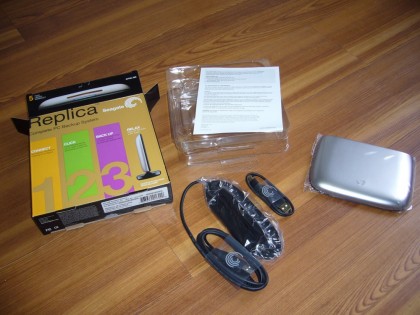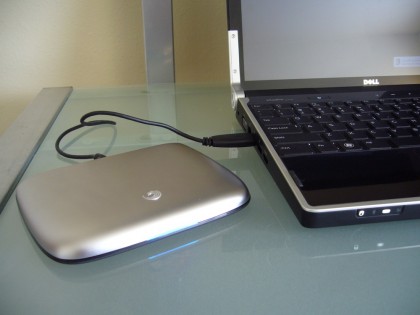The Seagate folks recently sent me a pair of devices to check out, including Replica – their newer, sleek and slim bundled hardware+software PC backup solution. I wasn’t sure I’d find time to play with it before the big move, but Melissa’s Dell Studio XPS 13 has been in need of some TLC. Her laptop rocks, other than early lockups which I cleared with a few Dell updates, and is by far the fastest 13″ computer (Mac or PC) I’ve ever used. However, at some point, the Vista install was corrupted. (I’m guessing a non-graceful shutdown, but the jury’s still out on the root cause.) The boot sequence has been full of errors and we’ve been unable to install any software, such as iTunes.
My plan had been to backup her computer using Replica as a precaution and then upgrade the XPS to Windows 7. As it turns out, Vista was so hosed I couldn’t even get Replica working. So, we rolled the dice and went for a Vista -> Win7 upgrade with merely a file copy to USB. I figured we had a 50/50 chance of an in-place upgrade working, without requiring a clean install. Fortunately, it went smoothly and all Windows errors/issues have been resolved. Although, we ended up with a non-functional version of Trend Micro under W7 – now replaced with the Microsoft Security Essentials beta.
The Replica install and config was ridiculously simple/automated, taking just a moment or so. Attach drive, let it update itself, backup of primary partitions begins. I guess the only complaint I could have is completing the required (?) registration splash screen before kicking it all off. Like Apple’s Time Machine, Seagate does it’s thing in the background when a drive is connected, providing both file level restoration and disaster recovery (via included boot CD). The Replica is offered as a 250GB single PC model (~$100) and 500GB multi-computer edition ($~180). And the primary difference, other than capacity, is the higher tier unit ships with a dock.
For a hundred bucks, I don’t think you can go wrong – a sleek, quiet, and cool drive with thought-free backup software. Of course, the real value of this solution won’t be known until attempting a system restore… which is something I’d rather avoid.
Click to enlarge:


It’d be about three bucks to back up the same amount of data using Amazon’s S3. FYI.
When’s all said and done (migrating her iTunes collection), Melissa probably will have about 80GB of data. We could back it up to the cloud (and I used to use Mozy and then SugarSync), but with bandwidth caps and the ability to do a full system restore locally this is a preferable solution for many.
Unless you test restore, all you’ve done is waste time and money.
I had a Maxtor (a Seagate brand) One Touch Turbo configured as RAID-1. One of the drives failed, and instead of indicating the failure and allowing me access to my data (which would be the point of RAID-1), the whole device dropped off the bus.
Basically, I had to choose between my data and the warranty. I chose my data.
I’ve verified all her data has been duplicated onto the drive and is accessible. What I haven’t verified is restore imaging option/process. Worse case scenario: data is safe, but many hours rebuilding. We can live with that risk.
Not to mention, this is a review item. I need to figure out if I can wipe it without destroying the backup function. But I’m fairly certain I’ll buy us one (the $99 edition) when this goes back or is given away after we’re moved.
My original hope had been to use a HP MediaSmart server for backing up multiple OSes and multiple computers on the network, but that failed due to some misleading marketing from HP.
Fortunately, I’m anal and therefore redundant in protecting my stuff.